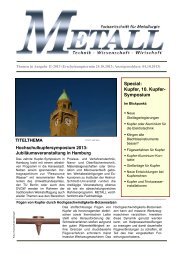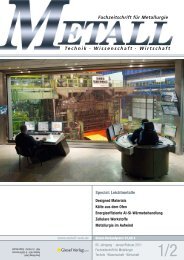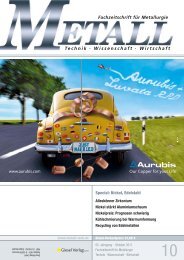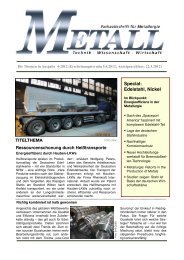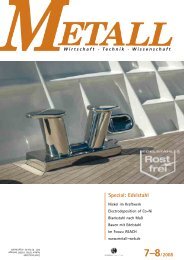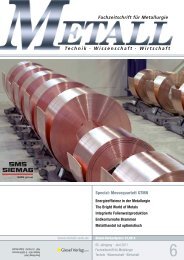BIR-Herbsttagung, 25. - 26- Oktober 2010 in Brüssel - Metall-web.de
BIR-Herbsttagung, 25. - 26- Oktober 2010 in Brüssel - Metall-web.de
BIR-Herbsttagung, 25. - 26- Oktober 2010 in Brüssel - Metall-web.de
Sie wollen auch ein ePaper? Erhöhen Sie die Reichweite Ihrer Titel.
YUMPU macht aus Druck-PDFs automatisch weboptimierte ePaper, die Google liebt.
METALL-FORSCHUNG<br />
Fig. 2: Depen<strong>de</strong>nce of Zn yield from the time<br />
granularity of z<strong>in</strong>c ash No.3 <strong>in</strong> 10% and 15%<br />
HCl at ambient temperature<br />
the copper recovery <strong>de</strong>creases. The<br />
reason for that is cement<strong>in</strong>g out with<br />
z<strong>in</strong>c. By the leach<strong>in</strong>g of the same fraction<br />
of ash <strong>in</strong> 10% and 15% HCl the<br />
maximum yield of z<strong>in</strong>c was obta<strong>in</strong>ed<br />
after 20 m<strong>in</strong>utes. Un<strong>de</strong>r these conditions<br />
practically all z<strong>in</strong>c was leached.<br />
Based on these results the most appropriate<br />
concentration of the leach<strong>in</strong>g<br />
solution was set to 10% HCl; the<br />
use of higher concentrations has no<br />
practical mean<strong>in</strong>g. The choice of 10%<br />
HCl concentration for the leach<strong>in</strong>g<br />
of z<strong>in</strong>c ash is <strong>in</strong> accordance with the<br />
concentration of the leach<strong>in</strong>g solution<br />
<strong>in</strong> the experiments of Dvořák and Jandová<br />
[6]. The highest yield of Zn us<strong>in</strong>g<br />
different concentrations of HCl (5%,<br />
10%, 15%) is shown <strong>in</strong> fig. 4.<br />
Effect of particle size on z<strong>in</strong>c<br />
recovery<br />
Based on the previous results, 10%<br />
HCl was selected to assess the impact<br />
Fig. 3: Depen<strong>de</strong>nce of Zn, Fe, Cu, Cd yield,<br />
from the time, the gra<strong>in</strong> size of z<strong>in</strong>c ash No. 3<br />
<strong>in</strong> 5% HCl, at ambient temperature<br />
602<br />
of the ash gra<strong>in</strong> size on the z<strong>in</strong>c yield.<br />
To assess the impact of the gra<strong>in</strong> size<br />
on the z<strong>in</strong>c yield four fractions with<br />
gra<strong>in</strong> size 1 – 4 have been leached.<br />
The leach<strong>in</strong>g period was 180 m<strong>in</strong>utes.<br />
No significant effect of particle size<br />
on the yield of z<strong>in</strong>c was found, with<br />
the exception of the f<strong>in</strong>est fractions<br />
(d < 0.125 mm), where the leach<strong>in</strong>g<br />
reached a higher yield compared to<br />
the other fractions. Recoveries of z<strong>in</strong>c<br />
above 90% were reached <strong>in</strong> <strong>in</strong>dividual<br />
fractions [10].<br />
Conclusion<br />
Z<strong>in</strong>c ash generated <strong>in</strong> hot batch galvaniz<strong>in</strong>g<br />
due to the high z<strong>in</strong>c content<br />
(70 - 96% Zn) is a valuable secondary<br />
raw material. It can be processed by<br />
hydrometallurgical and also pyrometallurgical<br />
methods. The work was<br />
focused on the hydrometallurgical<br />
process<strong>in</strong>g. We have focused especially<br />
on the leach<strong>in</strong>g <strong>in</strong> acid with the<br />
aim to leach z<strong>in</strong>c. Based on the results<br />
of the experiments it was <strong>de</strong>term<strong>in</strong>ed<br />
that the most appropriate concentration<br />
of the leach<strong>in</strong>g solution is 10%<br />
hydrochloric acid.<br />
Us<strong>in</strong>g a higher concentration is not<br />
important from the practical standpo<strong>in</strong>t.<br />
The monitor<strong>in</strong>g of the time <strong>de</strong>pen<strong>de</strong>nce<br />
of the yield of z<strong>in</strong>c showed<br />
that the maximum yield is achieved<br />
after 20-30 m<strong>in</strong>utes. When assess<strong>in</strong>g<br />
the impact of the z<strong>in</strong>c ash particle<br />
size on the z<strong>in</strong>c yield no significant<br />
effect was observed <strong>in</strong> the range of<br />
these fractions. On the basis of the<br />
results, as well as the observation<br />
with the eye, a higher yield was <strong>de</strong>tected<br />
<strong>in</strong> the f<strong>in</strong>est gra<strong>in</strong> size fraction<br />
with d < 0.125 mm than <strong>in</strong> other fractions.<br />
In that fraction almost all z<strong>in</strong>c<br />
is leached. The extracted extract with<br />
the high z<strong>in</strong>c content is suitable for<br />
further process<strong>in</strong>g <strong>in</strong> or<strong>de</strong>r to obta<strong>in</strong><br />
z<strong>in</strong>c. A suitable method is the electrolytic<br />
extraction after tak<strong>in</strong>g steps<br />
of the ref<strong>in</strong>ery and z<strong>in</strong>c carbonate<br />
precipitation.<br />
Acknowledgment<br />
This work was supported by Slovak<br />
Grant Agency for Science VEGA<br />
1/0134/09.<br />
Fig. 4: The highest yield of Zn <strong>in</strong> 5, 10, 15 %<br />
HCl dur<strong>in</strong>g leach<strong>in</strong>g time of 60 m<strong>in</strong> with gra<strong>in</strong><br />
of ash No. 3, at ambient temperature<br />
References<br />
[1] International z<strong>in</strong>c association. Available<br />
on Internet: < http://www.iza.com/<br />
recycl<strong>in</strong>g.html>.<br />
[2] HAVŘÁNKOVÁ, Z.: Žárové z<strong>in</strong>kování<br />
ponorem - Základní <strong>in</strong>formace pro<br />
uživatele. In: Konstrukce, 3, 2005.<br />
[3] KRIŠTOFOVÁ, D.: Recyklace<br />
neželezných kovů. Ostrava, 2003. s. 24-<br />
<strong>26</strong>. ISBN 80-248-0485-9.<br />
[4] Vyhláška č. 284/2001 Z.z. M<strong>in</strong>isterstva<br />
životného prostredia Slovenskej republiky,<br />
ktorou sa ustanovuje katalóg odpadov.<br />
Available on Internet: .<br />
[5] BARAKAT, M.A.: Pyrometallurgical<br />
process<strong>in</strong>g of z<strong>in</strong>c ash and flue dust. In:<br />
Acta <strong>Metall</strong>urgica Slovaca, 9, 2003, s.<br />
259-<strong>26</strong>9.<br />
[6] DVOŘÁK, P. - JANDOVÁ, J.: Z<strong>in</strong>c<br />
recovery from chlori<strong>de</strong>-bear<strong>in</strong>g galvaniz<strong>in</strong>g<br />
waste. In: Acta <strong>Metall</strong>urgica<br />
Slovaca, 12, 2006, s. 90-94.<br />
[7] The Nachi Dross Skimm<strong>in</strong>g Robot for<br />
Strip Galvaniz<strong>in</strong>g L<strong>in</strong>es. Available on<br />
Internet: .<br />
[8] VOURLIAS, G. et. al.: Study of the<br />
structure of hot-dip galvaniz<strong>in</strong>g byproducts.<br />
In: Journal of optoelectronics<br />
and advanced materials, 9, 2007, p.<br />
2937-2942.<br />
[9] Metaullics systems for z<strong>in</strong>c and galvaniz<strong>in</strong>g.<br />
Available on Internet: .<br />
[10] TAKÁČOVÁ, Z.: Diplomová práca:<br />
Možnosti spracovania z<strong>in</strong>kového<br />
popola vznikajúceho pri žiarovom<br />
poz<strong>in</strong>kovaní, Košice, 2009, s. 37 – 49.<br />
(1) Technical University of Knosice,<br />
Fakulty of <strong>Metall</strong>urgy, Department<br />
of Non-Ferrous Metals and<br />
Waste Treatment, Letná 9, 042 00<br />
Košice, Slovensko<br />
12/<strong>2010</strong> | 64. Jahrgang | METALL




